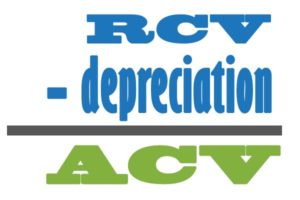 Following an insured loss, there are many new terms you’ll be introduced to. Three of those terms are Replacement Cost Value (RCV), Actual Cash Value (ACV) and depreciation. Application and definition of these words can be confusing and it’s important that you understand the terms to help settle your claim fairly.
Following an insured loss, there are many new terms you’ll be introduced to. Three of those terms are Replacement Cost Value (RCV), Actual Cash Value (ACV) and depreciation. Application and definition of these words can be confusing and it’s important that you understand the terms to help settle your claim fairly.
An easy way to understand RCV and ACV is to think in terms of “new” and “used.” Replacement cost is the item’s current price, new. “What will it cost when I replace it?” Actual cash is the item’s used price, old. “How much money is it worth since I used it for five years?”
Hold Back
Most policies only pay the Actual Cash Value upfront, and then they pay you the “held back” depreciation after you incur the expense to repair or replace your personal property items.
NOTE: You must remember to send documentation to the insurance company proving you’ve incurred the additional expense before you will be reimbursed.
Replacement Cost (RCV)
RCV is the maximum amount your insurance company will pay you for damage to covered property before deducting for depreciation. The RCV payment is based on the current cost to replace your property with new, identical or comparable property.
Actual Cash Value (ACV)
ACV is the amount your insurance company will pay you for damage to covered property after deducting for depreciation. ACV is the replacement cost of a new item, minus depreciation. If stated as a simple equation, ACV could be defined as follows: ACV=RCV-Depreciation
Unfortunately, ACV is not always as easy to agree upon as a simple math equation. The ACV can also be calculated as the price a willing buyer would pay for your used item.
Depreciation
Depreciation (sometimes called “hold back”) is defined as the “loss in value from all causes, including age, and wear and tear.” Although the definition seems to be clear, in our experience, “value” as a real-world application is clearly subjective and varies widely. We have seen the same adjuster apply NO depreciation (100 percent value) on one claim and 40 percent depreciation (almost half value) on an almost identical claim. This shows that the process of applying depreciation is subjective and clearly negotiable.
Excessive Depreciation
When the insurance company depreciates more than they should, it is called “Excessive Depreciation.” Although not ethical, it is very common. Note any items that have excessive depreciation and write a letter to your insurance company.
More detail can be found in Chapter 4 of our free eBook “A Survivor’s Guide to Insurance”
